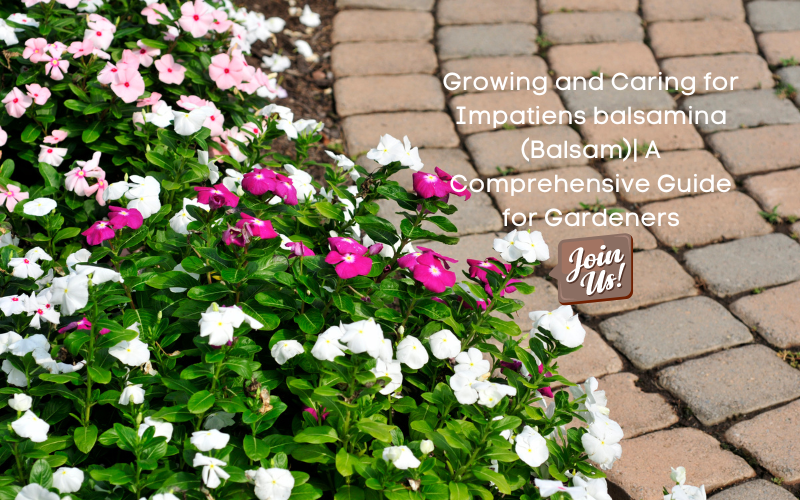+91 9493616161
+91 9493616161

Introduction
Balsam, also known as Impatiens balsamina, is a beautiful annual plant that belongs to the Balsaminaceae family. The plant is native to India and Sri Lanka, but it is now widely cultivated in many other parts of the world, including the United States, Europe, and Australia. Balsam is a popular garden plant due to its bright and showy flowers, which come in a wide range of colors. In this guide, we will discuss everything you need to know about balsam, including its origin, growth requirements, propagation, and uses.
Origin and Distribution
As mentioned earlier, balsam is native to India and Sri Lanka. The plant was introduced to other parts of the world in the 16th century, and it has since become naturalized in many regions. Today, balsam is widely cultivated in tropical and subtropical regions worldwide, including the Caribbean, South America, Africa, and Southeast Asia.
Description
Balsam is an annual plant that grows to a height of 1-2 feet. The plant has a bushy and upright growth habit, with a branching stem that bears oval-shaped leaves. The leaves are light green in color and have toothed edges. Balsam produces large and showy flowers that come in a wide range of colors, including pink, red, purple, white, and orange. The flowers are double or single, and they bloom from summer to fall.
Growth Requirements
Balsam is a relatively easy plant to grow, provided that you meet its basic growth requirements. Here are some of the growth requirements for balsam:
Balsam requires full sun to partial shade to thrive. The plant does best in a location that receives at least 4-6 hours of direct sunlight per day. In hot and dry climates, balsam can benefit from some afternoon shade to prevent wilting.
Balsam grows best in well-draining soil that is rich in organic matter. The soil should be slightly acidic, with a pH of 6.0-6.5. If your soil is heavy or clayey, you can amend it with organic matter, such as compost or well-rotted manure, to improve drainage and fertility.
Balsam requires regular watering to keep the soil evenly moist. The plant is not drought-tolerant, and it can quickly wilt and drop its leaves if it becomes too dry. However, overwatering can also be detrimental to balsam, as it can cause root rot and other fungal diseases. Water the plant deeply once or twice a week, depending on the weather and soil conditions.
Balsam prefers warm temperatures, with a minimum temperature of 60°F. The plant can be damaged by frost and cold temperatures, so it is best to grow it in the summer or as an indoor plant. Balsam also prefers high humidity, but it can tolerate moderate levels of humidity.
Balsam benefits from regular fertilization to support its growth and flowering. You can use a balanced fertilizer, such as 10-10-10, every two weeks during the growing season. Alternatively, you can use a slow-release fertilizer that releases nutrients over a more extended period.
Propagation
Balsam can be propagated by seed or cuttings. Here are the steps for propagating balsam:
a. Collect the seeds from mature balsam flowers. The seeds are small and black.
b. Sow the seeds in a seed-starting mix or a well-draining potting soil. Cover the seeds lightly with soil.
c. Water the soil thoroughly and place the container in a warm and bright location.
d. Keep the soil moist and wait for the seeds to germinate, which typically takes 7-14 days.
e. Once the seedlings have developed true leaves, you can transplant them to larger containers or the garden.
a. Take 4-6 inch cuttings from the tips of healthy balsam plants. Make the cut just below a node.
b. Remove the lower leaves from the cutting, leaving only a few leaves at the top.
c. Dip the cut end of the stem in rooting hormone to promote root growth.
d. Plant the cutting in a well-draining potting mix or soil.
e. Water the soil and place the container in a bright and warm location.
f. Keep the soil moist and wait for the cutting to root, which typically takes 2-4 weeks.
g. Once the cutting has developed roots, you can transplant it to a larger container or the garden.
Uses
Balsam is primarily grown for its attractive flowers, which make it a popular garden plant. The plant is often used in mixed borders, flowerbeds, and container gardens. Balsam is also a favorite of hummingbirds and butterflies, which are attracted to its colorful flowers. In addition to its ornamental value, balsam has some medicinal uses. In traditional medicine, the plant has been used to treat skin rashes, wounds, and other ailments.
Potential Issues
Balsam is relatively low-maintenance and does not have many significant pest or disease problems. However, there are a few issues that you should be aware of:
Balsam can be susceptible to fungal diseases, such as powdery mildew and leaf spot. To prevent these diseases, avoid overhead watering, provide good air circulation, and remove infected leaves promptly.
Balsam can attract aphids, spider mites, and whiteflies. These pests can be controlled with insecticidal soap or neem oil.
Balsam is prone to wilting in hot and dry weather, especially if the soil is not kept moist. To prevent wilting, water the plant deeply and provide some afternoon shade if necessary.
Conclusion
Balsam is a beautiful and easy-to-grow plant that adds color and interest to any garden. With its showy flowers and attractive foliage, balsam is an excellent choice for beginners and experienced gardeners alike. By following the growing tips and care guidelines in this guide, you can enjoy the beauty and benefits of balsam in your own garden.
Leave a comment